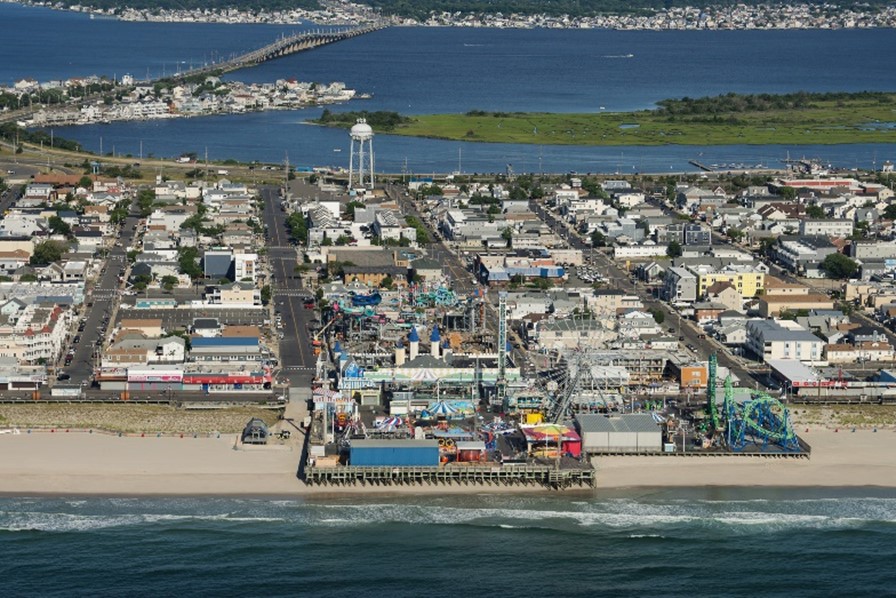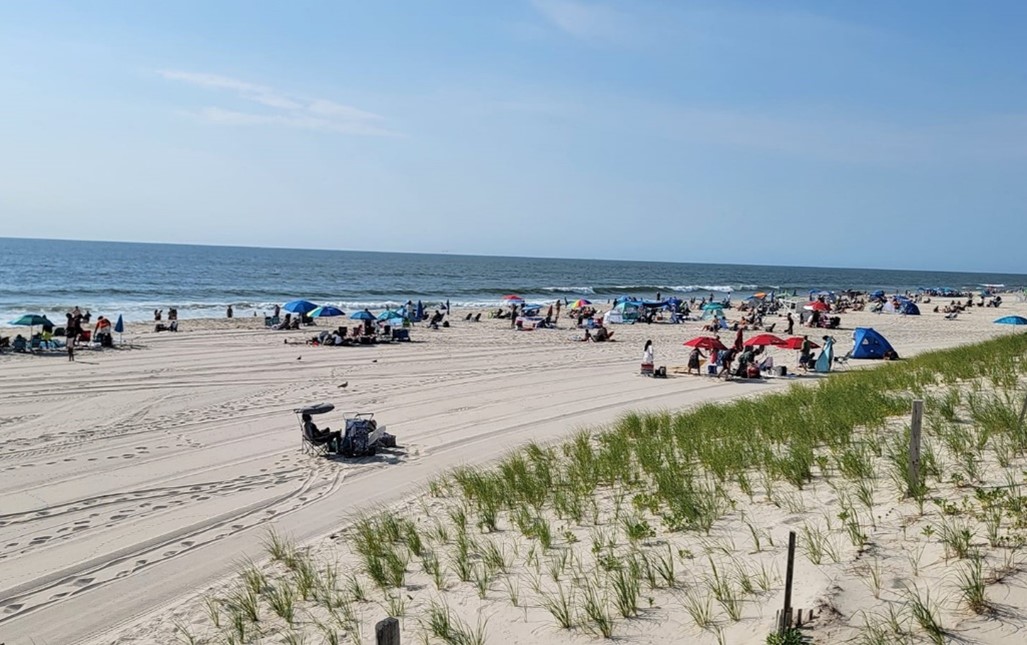FOR IMMEDIATE RELEASE
May 22, 2025
Contact: Vincent Grassi (609) 984-1795
Lawrence Hajna (609) 984-1795
Caryn Shinske (609) 984-1795
COMMISSIONER LATOURETTE DECLARES JERSEY SHORE AND LAKES READY FOR SUMMER TOURISM SEASON
(25/P27) TRENTON – New Jersey’s coastal beaches and inland lakes are ready for the summer tourism season, Environmental Protection Commissioner Shawn M. LaTourette announced today during the annual State of the Shore event in Asbury Park.
 “Water quality is excellent, and all across New Jersey communities are ready for what will surely be another season of summer fun,” Commissioner LaTourette said during the State of the Shore event in Asbury Park. “Behind the scenes, state and local officials have been hard at work to ensure everyone has a safe and enjoyable summer – so get out there and enjoy.”
“Water quality is excellent, and all across New Jersey communities are ready for what will surely be another season of summer fun,” Commissioner LaTourette said during the State of the Shore event in Asbury Park. “Behind the scenes, state and local officials have been hard at work to ensure everyone has a safe and enjoyable summer – so get out there and enjoy.”
Each year, the State of the Shore event sponsored by the New Jersey Sea Grant Consortium helps to kick off the summer tourism season by updating the public on beach readiness and coastal water quality. The Commissioner also provided an overview of conditions for the state’s large freshwater lakes; his traditional coastal surveillance flight was canceled due to poor weather conditions.
“The New Jersey Sea Grant Consortium is proud to once again partner with the NJDEP and Commissioner Shawn LaTourette for our annual State of the Shore event. This press forum, featuring the release of our report and insights from coastal experts, kicks off the conversation around the current state of New Jersey’s ocean beaches and shorelines as we head into the 2025 beach season,” said Sea Grant Consortium Executive Director Dr. Peter Rowe. “The public and our beach communities receive valuable and actionable information on beach conditions and tropical storm outlooks to help them plan their time ‘down the shore.’”
As the Jersey Shore gets ready to welcome visitors for the Memorial Day weekend and season, the State Park Service is also preparing for a busy summer. Lifeguards at Island Beach State Park will return to the stands from 10 a.m. to 6 p.m. Saturday, May 24 through Monday, May 26, and then on weekends only until June 14. Beginning June 14, lifeguards will be on duty daily from 10 a.m. to 6 p.m. through Labor Day, Sept. 1. The State Park Service’s lakefront swim areas will open on staggered dates in mid-June.
State of the Lakes
 DEP is committed to a safe and enjoyable season for visitors to New Jersey’s lake communities, which play an important role in the state’s tourism economy. For the first time this year, visitors can check the daily beach status for advisories and/or closures due to bacteria levels that exceed the state’s water quality standard as well as any closures for Harmful Algal Blooms (HABs) at New Jersey’s freshwater public bathing beaches on njbeaches.org, the long-running and successful online information source that provides the public with daily information about water quality and beach status for coastal areas.
DEP is committed to a safe and enjoyable season for visitors to New Jersey’s lake communities, which play an important role in the state’s tourism economy. For the first time this year, visitors can check the daily beach status for advisories and/or closures due to bacteria levels that exceed the state’s water quality standard as well as any closures for Harmful Algal Blooms (HABs) at New Jersey’s freshwater public bathing beaches on njbeaches.org, the long-running and successful online information source that provides the public with daily information about water quality and beach status for coastal areas.
The Freshwater Beach Monitoring Program is a partnership between the New Jersey Department of Health, local health authorities and DEP, and currently covers more than 30 public freshwater beaches across Bergen, Burlington, Camden, Cumberland, Gloucester, Morris, Ocean, Passaic, Sussex, Warren, Hunterdon, Middlesex and Salem counties.
To better protect lake water quality and help local governments make informed decisions for water quality enhancements, as well as enhance public awareness of Harmful Algal Blooms that occur in the state’s freshwater lakes, DEP continues to conduct surveillance flights and respond to HAB reports obtained from the public and through its volunteer monitoring partners.
Additionally, a recent enhancement to the way volunteers report potential HABs to DEP has allowed for a more effective evaluation of potential HAB occurrences and has enabled a more efficient response compared to previous years. The collected data is used for screening purposes, to assess the status of confirmed HABs, and informs DEP on appropriate response actions.
“In New Jersey, summer memories aren’t only made at the shore—they’re also created on the peaceful waters of our lakes. At Lake Hopatcong, the state’s largest freshwater lake, locals and visitors alike enjoy everything from fishing and boating to lakeside dining and community events,” said Kyle Richter, Executive Director of the Lake Hopatcong Foundation.
“This vibrant way of life depends on clean water, which fuels both recreation and the regional economy. Through a strong partnership with the NJDEP, vital projects are underway to protect water quality and ensure Lake Hopatcong remains a healthy, welcoming destination all year long.”
DEP also operates 10 water quality monitoring buoys that measure various water quality parameters 24 hours per day, seven days per week. They are deployed at Lake Hopatcong, Swartswood Lake, Spruce Run Reservoir, Budd Lake, Manasquan Reservoir, Carnegie Lake, and Greenwood Lake. There are also plans to deploy buoys at Greenwich Lake, Parvin Lake and Weequahic Lake. Data from the continuous monitoring buoys can be found at njdep.rutgers.edu/continuous/
State of the Shore
During the Asbury Park event today, Dr. Jon K. Miller, Sea Grant Coastal Processes Specialist and Director of the Coastal Engineering Group and Research Associate Professor at the Stevens Institute of Technology, provided an overview of beach conditions along the coast.
“Due to the combination of a lack of storms and efforts by federal, state, and local officials to maintain and replenish beaches where necessary, most of the state’s beaches are in excellent condition heading into the Memorial Day weekend,” said Dr. Miller.
New Jersey’s coastal beaches fared well during the 2024 Atlantic hurricane season. Impacts to the beach and dune systems were minimal and mostly temporary.
Since the end of the 2024 hurricane season, New Jersey has not experienced any significant coastal storms. Most of the weather events that influence erosion were short-lived, which has left much of the New Jersey coast in good shape for the summer tourism season.
Using a multifaceted approach, the Murphy Administration has worked to make New Jersey more resilient to climate change through investments in non-structural and natural and nature-based features, engineered shore protection projects, buyouts, home elevations and more.
DEP has forged strong partnerships with stakeholders, including local and federal partners, to implement a comprehensive approach to coastal resilience planning and adaptation. A key part of this strategy includes robust dune and beach construction and nourishment projects.
The U.S. Army Corps of Engineers, in partnership with DEP, successfully completed two periodic beach replenishment projects this year – one in Lower Cape May Meadows and the other along Absecon Island. Additionally, work is ongoing to complete two other nourishment efforts in Northern Ocean County and Long Beach Island.
DEP partners with local health agencies to conduct weekly bacterial water sampling of ocean, river and bay beaches from mid-May through September as part of its Cooperative Coastal Monitoring Program. In addition, the program conducts daily surveillance flights of the coastline and lakes to check for any water quality concerns. Information about the status of public recreational beaches and water quality is available at njbeaches.org.
During the 2024 season, water quality was monitored at 193 ocean beaches as well as 18 bay and six river stations. There were no ocean, bay, or river beach closures due to exceedances of the bacterial standard.
Follow @NJBeachReport on X for daily updates on the status of New Jersey coastal and freshwater bathing beaches during the summer.
###